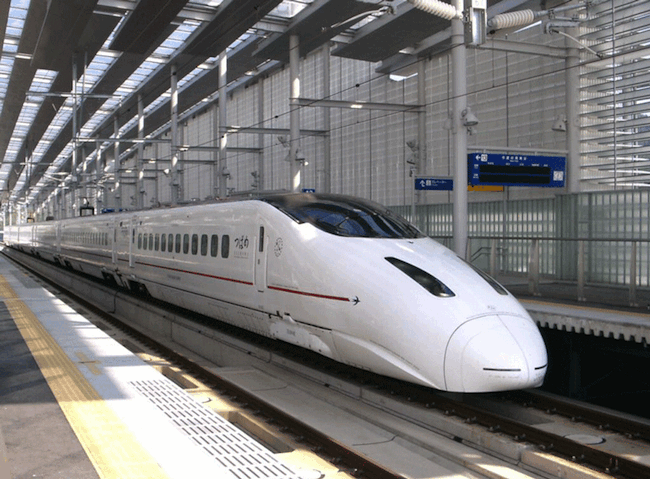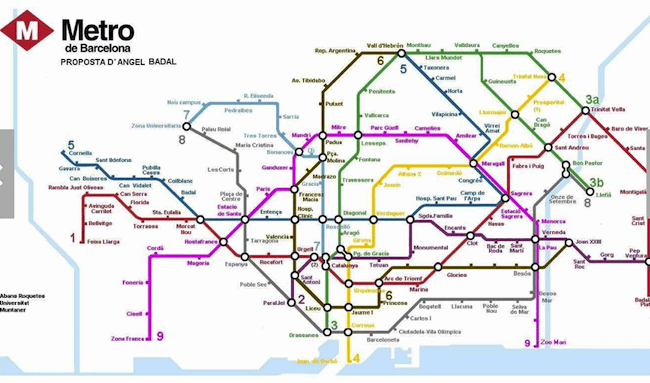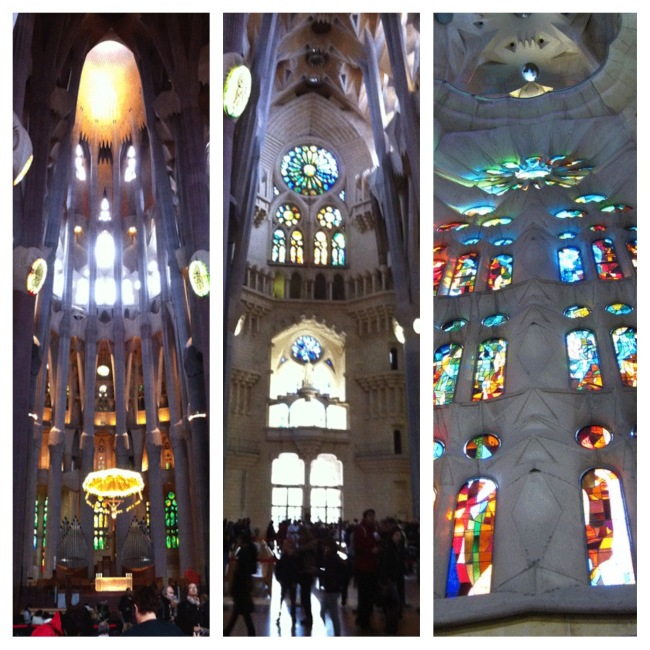A Sensational Time-Lapse Story in Barcelona
by Elyn Aviva
Rumbling vibration of Spanish high-speed AVE train, coming into the deep underground white glass-brick cement plaster metal station in Girona. Feet tingle on platform, train sloowwwwws waaaayyyyyyy dowwwwwwnnnn and coasts to stop. Sigh like a long-held outbreath as doors open, stairs unfold. Clack thump of discharging passengers maneuvering out and down and onto platform, luggage dangling.
We wait to get on. Impatience has a metallic feel.

Finding our seats, sinking in. Ahh. Whoosh of doors closing, train starting, gaining speed. 200 kms/hour. Fast. Train car is more or less silent, except for the gaggle of girls behind us, a before-wedding hen party heading to Barcelona. They sport puffy red heart pins on their sweaters, move grudgingly when I push through to the semi-circular toilet cubicle at the end.
Ground mist rises like whipped cream, hiding the dark green hills. Rain smears against the windows, streams rushing tumultuous but soundless, muddy swirling water caressing tree roots in a cold embrace.
200 kms/hour, now 150, now 50, now 6…. Slow sigh of arrival. Sants Estación, Barcelona. Hurry down the platform, up the escalator, across the station toward Metro entrance. Huge Metro map on wall, angular routes snaking over it, marking the underground root-network beneath the city. Choose your color, your number, your direction. Linea 5, sky blue, direction Vall de Hebron, intermediate node, Sagrada Familia. Repetitive thump squeak of footsteps on tile corridor, down one flight of stairs, onto slow moving escalator… Pause. Shift. Wait.
Tension builds. People jostle to buy tickets. Which way does the ticket arrow go in the machine to get through the gate? Will the baby buggy get caught in the vertical gyrating windmill turnstile? Why doesn’t it work? Put it in again. Lose a journey.
How much farther down? Have we missed the train?
Bright flashing sign gives countdown to arrival. Compressed sound vibrates in the tunnel, breaks screech metal on metal. Beep 3x: doors open. Hurry. Doors close. 3 more beeps.
Watch your bag, your pocket, your back. Last week someone stole my iPhone but I got it back. Miracles occur. So does theft.
A familiar face appears out of the blurring crowd. Short black hair, immense brown eyes. Ferran! Kisses, hugs. Here? A smile. Yes. On his way to his office. We will see him later. He takes our heavy black shoulder bag.
Subway stops, brakes grind like knife on wheel. Ferran moves out the door, disappears.
We start again, fall back with acceleration, grab railing, handholds, each other. Hold hands.
Lights blink on the serpentine map over the door, marking the discontinuous journey punctuated by stops. Next stop. Next stop. The next. Sagrada Familia. Push button beside the door—bright hiss, doors creak open. Push through crowd, step down, 3 beeps, doors close.
Turn left or right? Arrow on wall points right to Sagrada Familia Plaza. Hurry hurry. Abrupt stop: person in front stands still, reading map. Boulder in white-water rush. Impatient, wait. Wait. Go around. Stop. Go. Claim place as escalator unfolds from smooth ramp to serrated steps.

Emerge like moles blinking in light. Rain splattering cement, dripping dark down walls. Pause. Our umbrellas are in our shoulder bag. With Ferran. Buy umbrella from vendor just before exit. Good business, that.
Run up slick wet staircase. Where are we? Look up. Towers tower. Line of many colors, interlocking umbrellas moves slowly around the block like a rainbow caterpillar. We scurry to a different entrance, Guest Entrance/Online tickets. Fumble in purse, find red plastic “Friends of Sagrada Familia” cards. Priority entry. Run up pavement into shelter of immense sculpted entry, dodging photos and photo-takers, iPads raised like flattened SLRs.
Ignore huge statues of anguish grief pain betrayal. Walk around Christ chained to post. Why do they call it “The Passion”?
Inside. Furl umbrella, dripping on floor.
Tour groups mill like schools of fish, flocks of birds, leader in front. Chatter. Headphones, audio guides held to ears, people strolling, stopping, necks craned upward, jaws gaping at the linear forest of huge fluted white columns branching into inverted parabolic arches half-way to heaven. A gravity-denying canopy of stone and concrete. Huge backlit opalescent oval shields etched in black with angel, lion, eagle, bull, stand-ins for the four Evangelists. They glow like beacons high above the crowds, perched on the four columns that mark the intersection of central corridor—the nave—and the crossing. Crossing the crossing, intersecting the horizontal crucifix marked by columns on the floor.
Beyond: the main altar, up a flight of steps. Agonized Christ impaled on crucifix, knees drawn up, grimacing in pain, floating in space, protected by an umbrella-canopy circled with golden letters. Grape clusters dangle from the baldachin. “This is my blood?” A coded reference to transformation?
High above, the golden skylight of gleaming triangles hangs like a crystal chandelier.
Walls pierced with brilliance: blue green red purple stained glass streaming light like crushed sapphires rubies emeralds amethysts. Farther down the nave, pale grey rainy-day light flows unchanged through transparent windows.
The nave is cordoned off, filled with chairs. We walk clockwise to the left, toward the chapel behind the main altar, separated by a wall, its narrow entry guarded. Prayer only the sign says. No cameras, no phones. We are eager to return to this sweet spot of silence and gentle energy in the midst of movement, the place we have come to visit, the place we always come to visit.
The guard bars our entry. No. Not now. The space is reserved for a tour group that hasn’t yet arrived. Wait 20 minutes he says firmly. I argue. Just 5 minutes? I plead. No. Not now.
Annoyance, irritation. Is this a holy place or a tourist operation? I answer my own question. Both. The money pays for the building project.
Gary reminds me: Let go, relax, there is more to do, other places to be.
Walk down to the opposite end, enter the nave behind the cordons, move toward the altar past chatting visitors sitting in chairs iPhones ringing, cameras snapping, move toward a space marked “Prayer only.” Stand in center, take photo. Guard shakes hand, gestures: No. You must sit down. No standing in the center.
We move forward to the section set aside for prayer and sit.
Silence wraps us like a blanket, engulfs us like thick, creamy fog. We sink deep into space, motionless, descending like lead weights in the sea. Movement around us, on either side of the cordons, fades. Music gently whispers, rises gradually in volume. Sacred sounds surround the Inner Stillness, uttering the Word. We are here. We are here. We are here.
We are nowhere.
Author's note: This piece was inspired by musing on story maps vs. grid maps, as described in Robert Macfarlane’s The Wild Places. Contemplating the difference between a map—any kind of map—the territory, and the experience of getting there.
Elyn Aviva is a transformational traveler, writer, and fiber artist. Her blog is www.powerfulplaces.info. Currently living in Girona (Catalonia), Spain, she is fascinated by pilgrimage and sacred sites. Her PhD in anthropology was on the modern Camino de Santiago in Spain. Aviva is author of a number of articles, books, and novels on pilgrimage and sacred sites. She is co-author with her husband, Gary White, of the series “Powerful Places Guidebooks.” The most recent one is Powerful Places in Wales. To learn more about these publications, go to www.powerfulplaces.com and www.pilgrimsprocess.com. To learn about Elyn’s fiber art, go to www.fiberalchemy.com.
[Photography by Gary White]
